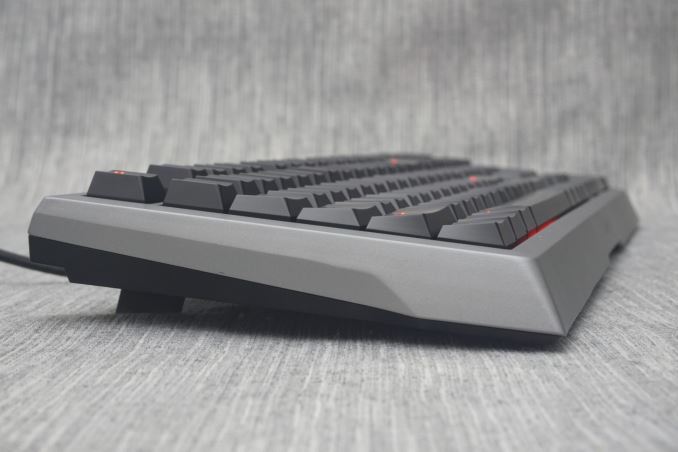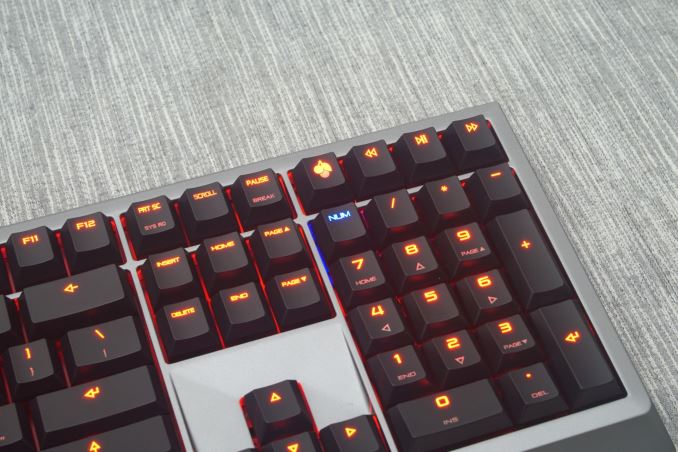The Cherry MX Board 6.0 Mechanical Keyboard Review
by E. Fylladitakis on January 27, 2016 8:00 AM EST- Posted in
- Keyboard
- Cherry MX
- Mechanical Keyboards
Conclusion
I always try to use every keyboard that we review as my personal keyboard for at least a week. My typical weekly usage includes a lot of typing (about 100-150 pages), a few hours of gaming and some casual usage, such as internet browsing and messaging. Cherry's use of MX Red switches on the MX Board 6.0 is odd, as it is being marketed as a professional keyboard and the MX Blue and MX Brown switches are generally the preferred switches for typing. Despite the use of MX Red switches, which are not my personal favorite for typing either, the MX Board 6.0 was remarkably responsive and comfortable for long typing sessions. The large wrist rest helped as well, maintaining the palms of my hands at a comfortable position over the length of the typing session.
For gaming, the MX Board 6.0 leaves us with mixed feelings. The Realkey technology is supposed to minimize the latency of the keyboard and provides true N-Key rollover, which is nice for gamers, and the keyboard itself is very comfortable for prolonged use. However, it also lacks any form of programmability, macro keys or even just the capability to run macros (without the use of third-party remapping software). For me, since my gaming style frequently relies on macros, the MX Board 6.0 was impractical during my gaming sessions. Nonetheless, those who do not use macros and/or remap their keyboard for gaming will not have any issue using the MX Board 6.0.
The Cherry MX Board 6.0 is undoubtedly a very high quality keyboard, designed to be virtually indestructible and very comfortable for advanced professional users. However, we found Cherry's design confounding. MX Blue/Brown switches are far more popular with typists than MX Red switches, so it is strange that the company decided to offer such a keyboard only with MX Red switches. It is also strange that Cherry included the Realkey technology into this model, as it would be a feature appreciated by gamers, but professionals are unlikely to be swayed by it. Furthermore, the MX Board 6.0 lacks any programmability, a feature that is almost a necessity for gamers nowadays, but also very helpful for many professionals as well.
In conclusion, we feel that the Cherry MX Board 6.0 is aimed towards a very small, specific target group - those who want a top quality keyboard and do not care about advanced features, such as a programmable layout or macro capabilities. It would be an excellent choice for anyone who wants to buy one (and only one) keyboard for years to come, even for gamers if they are certain that they will not need any advanced features.
However with that said, the MX Board 6.0 solid quality comes with one significant drawback, and that's price. The MX Board 6.0 currently retails at the very steep price of $198 plus shipping, which greatly limits its market potential. Professionals can find very good mechanical keyboard retailing for nearly half the price. The very best gaming keyboards using Cherry's own MX switches, such as the Corsair Vengeance K95 RGB and the Cougar 700K, retail for less than Cherry's own implementation, and those keyboards feature programmability, RGB lighting, and macro key functionality that the Cherry does not. As a result, while the Cherry MX Board 6.0 is a product of excellent quality and design, it's misplaced in the market due to a lack of competitive pricing - and that's a significant problem when that competition is based around Cherry's own switches as well.












72 Comments
View All Comments
buxe2quec - Wednesday, January 27, 2016 - link
http://www.cherry.de/cid/Mechanical_keyboards.htm? this is the listSamus - Wednesday, January 27, 2016 - link
Awesome keyboard, but I repeat your "Wow...$200" statement.I mean is it really that much better than a $60 Coolermaster Quickfire with the same MX Red keys?
valentin-835 - Saturday, January 30, 2016 - link
I used to think that way. 200 bucks. What's that ? I know people that spend more than that in a month drinking a lot of Starbucks coffee. Them caffeine junkies !!!voicequal - Wednesday, January 27, 2016 - link
Once you get adjusted to MX Red it's hard to go back to MX Brown. I have two Kinesis keyboards, the first was MX Brown, the 2nd MX Red. Compared to the MX Red, the MX Brown feels sticky and requires harder key presses, but then bottoms out abruptly. MX Red has light but consistent actuation force that allows faster typing while reducing fatigue, once you learn to not hammer the keys. I use the MX Red at work while the MX Brown stays home, while I've come to prefer the MX Red overall.MrSpadge - Wednesday, January 27, 2016 - link
Interesting. I definitely prefer MX Brown over MX Black. And I've got 2 examples for Brown's: a basic Cherry for ~50€ at work and a.. oh dear, forgot the name. From some other company for 120€, a heavy unit with a solid back plate. The keys feel so much better on that one, precise and light compared to "a bit mushy" - it's amazing. I would have sworn they use different ones if I didn't kow better.MrSpadge - Wednesday, January 27, 2016 - link
The better one is a Celeritas.BurntMyBacon - Thursday, January 28, 2016 - link
@MrSpadge: "... a heavy unit with a solid back plate. The keys feel so much better on that one, precise and light compared to "a bit mushy" "This is exactly my experience. I've had the opportunity to use browns and blacks at work. Waiting till prices are better in general for home as I'd like a backlit mechanical keyboard with a solid back plate for my dark environment, but I'm unwilling to pay the current going price for it. If the keyboard has flex in the back plate, the keys feel sticky and require a lot more actuation force. A solid back plate allows you to accurately feel the crossover point and waste no more time or energy on the key press. Blacks aren't really that bad for me, but with no feedback to tell me it has actuated, I end up bottomed out or nearly so every key press. Given that reds are less resistive, I'd probably be bottoming out every time.
guidryp - Wednesday, January 27, 2016 - link
People are different and I suppose you can get used to anything.But Browns and "harder key presses" doesn't make much sense, these are extremely light press keys.
That "bottoms out suddenly" is the tactile breakover effect, and is exactly what I want in a keyboard switch. It's the only reason I want a mechanical keyboard. I despise the linear black and red keys with the Linear keys you get no tactile cue about actuation, except bottoming them out.
voicequal - Thursday, January 28, 2016 - link
The Kinesis also helps by playing an audible "tick" sound when the key actuates. I've kept this on with both the Brown and Red, and I recall I did have trouble detecting feedback when I turned it off.I guess if the key is going to bottom out hard anyway, I'd rather have the Red which gives you more control over how fast you bottom out. Since the brown requires more initial force to actuate, your always going to bottom out hard. For me it agitates RSI.
BurntMyBacon - Thursday, January 28, 2016 - link
@voicequal: "The Kinesis also helps by playing an audible "tick" sound when the key actuates. I've kept this on with both the Brown and Red, and I recall I did have trouble detecting feedback when I turned it off."Good information. I didn't know the Kinesis keyboards had that feature. It's too bad the board has enough flex that you can't get a good response from the browns, but it sounds like the audible feedback is responsive enough to make the reds usable. This keyboard is not really in my price range, but perhaps the audible feedback scheme will show up elsewhere in the future.